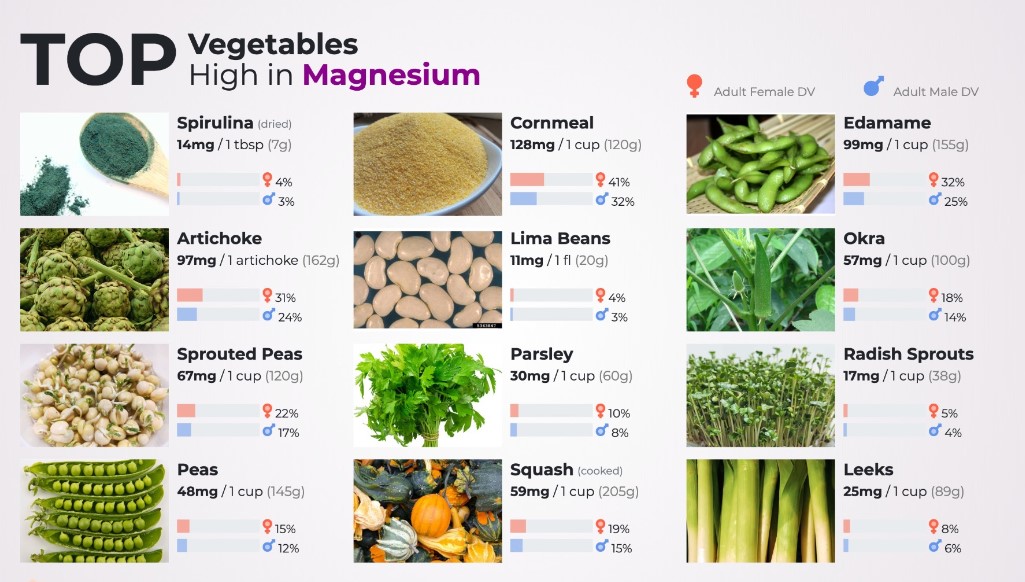BOURSESSENEGAL – If you’re looking to improve your diet, consider incorporating more foods high in magnesium. Magnesium plays a crucial role in various bodily functions, including muscle and nerve function, blood sugar control, and blood pressure regulation. Despite its importance, many people don’t consume enough magnesium daily. In this article, we’ll explore the benefits of magnesium, list magnesium-rich foods, and provide tips on how to incorporate them into your meals.
Why is Magnesium Important?
Understanding Magnesium’s Role
Magnesium is an essential mineral that contributes to numerous biochemical reactions in the body. It helps convert food into energy, assists in muscle contraction and relaxation, and supports the immune system. Additionally, magnesium plays a role in synthesizing DNA and protein, making it vital for growth and development.
Health Benefits of Magnesium
Increasing your magnesium intake can offer several health benefits, including:
- Improved Bone Health: Magnesium supports calcium absorption, essential for strong bones.
- Enhanced Muscle Function: Adequate magnesium levels can prevent muscle cramps and spasms.
- Better Heart Health: Magnesium helps regulate heart rhythm and may lower the risk of heart disease.
- Reduced Stress and Anxiety: Some studies suggest that magnesium may help reduce stress and improve mood.
Recommended Daily Intake of Magnesium
The recommended daily allowance (RDA) of magnesium varies based on age and gender. On average:
- Adult men: 400-420 mg
- Adult women: 310-320 mg
It’s essential to ensure you meet these daily requirements to support overall health.
Foods High in Magnesium
1. Leafy Greens
Spinach and Swiss Chard
Leafy greens like spinach and Swiss chard are excellent sources of magnesium. One cup of cooked spinach provides approximately 157 mg of magnesium, while the same amount of Swiss chard offers around 150 mg. Incorporating these greens into salads, smoothies, or stir-fries can significantly boost your magnesium intake.
2. Nuts and Seeds
Almonds, Cashews, and Pumpkin Seeds
Nuts and seeds are not only rich in healthy fats but also packed with magnesium. A quarter-cup of almonds contains about 97 mg of magnesium, while cashews provide around 74 mg per ounce. Pumpkin seeds are particularly high, offering approximately 168 mg in just a quarter-cup. Snack on these nutrient-dense foods or sprinkle them on your meals for added crunch.
3. Whole Grains
Brown Rice, Quinoa, and Oats
Whole grains are another great source of magnesium. One cup of cooked quinoa has around 118 mg, while brown rice provides about 84 mg per cup. Oats, particularly rolled oats, also contribute significantly, with roughly 61 mg per cup when cooked. Swap refined grains for whole grains to increase your magnesium levels and improve your overall health.
4. Legumes
Black Beans, Chickpeas, and Lentils
Legumes are not only high in fiber but also rich in magnesium. One cup of cooked black beans contains about 120 mg, while chickpeas provide around 79 mg. Lentils are also a good choice, offering approximately 71 mg per cup. Including legumes in your diet can enhance your magnesium intake and keep you feeling full longer.
5. Fish
Salmon and Mackerel
Certain fish, particularly fatty fish like salmon and mackerel, are excellent sources of magnesium. A 3-ounce serving of cooked salmon contains about 26 mg of magnesium, while mackerel provides around 97 mg. Enjoying fish a couple of times a week can contribute significantly to your magnesium needs.
6. Dark Chocolate
A Delicious Source of Magnesium
If you have a sweet tooth, you’ll be happy to know that dark chocolate is high in magnesium. One ounce of dark chocolate (70-85% cocoa) contains about 64 mg of magnesium. Indulging in dark chocolate can satisfy your cravings while also providing health benefits, including antioxidant properties.
7. Avocados
A Nutrient-Packed Superfood
Avocados are not only rich in healthy fats but also offer about 58 mg of magnesium per medium fruit. They make a great addition to salads, smoothies, or as a spread on toast. Plus, their creamy texture and flavor make them a versatile ingredient.
How to Incorporate More Magnesium-Rich Foods into Your Diet
Meal Planning Tips
To ensure you’re getting enough magnesium, consider these meal planning tips:
- Start with Breakfast: Incorporate oats topped with nuts or seeds for a magnesium-rich breakfast. Add fruit for extra flavor and nutrients.
- Snack Wisely: Keep magnesium-rich snacks like almonds, pumpkin seeds, or dark chocolate on hand for quick energy boosts.
- Add Legumes: Include legumes in salads, soups, or as side dishes. They can be easily added to various meals to enhance nutrition.
- Use Whole Grains: Replace refined grains with whole grains. Try brown rice, quinoa, or whole-grain bread in your meals.
- Experiment with Greens: Use leafy greens in salads, smoothies, or cooked dishes. Spinach, kale, and Swiss chard are versatile options.
Potential Risks of Magnesium Deficiency
Recognizing Symptoms
Magnesium deficiency can lead to various symptoms, including:
- Muscle cramps and spasms
- Fatigue and weakness
- Nausea and vomiting
- Irregular heartbeats
If you suspect you may have a magnesium deficiency, consult a healthcare professional for evaluation and advice.
Who is at Risk?
Certain populations are more susceptible to magnesium deficiency, including:
- Individuals with gastrointestinal diseases
- People with diabetes
- Those with a high intake of alcohol
- Older adults
If you fall into any of these categories, paying close attention to your magnesium intake is crucial.
Conclusion: Prioritizing Magnesium in Your Diet
Incorporating foods high in magnesium into your daily diet can significantly enhance your health. By focusing on leafy greens, nuts, seeds, whole grains, legumes, fish, dark chocolate, and avocados, you can easily meet your magnesium needs. Remember to plan your meals, snack wisely, and enjoy a variety of foods to ensure a balanced diet. By making small changes, you can boost your magnesium levels and support overall well-being. Don’t hesitate to consult a healthcare professional if you have concerns about your magnesium intake or overall nutrition. Your health is worth the investment!
REFERENCE : https://www.cdcfoundation.org/



